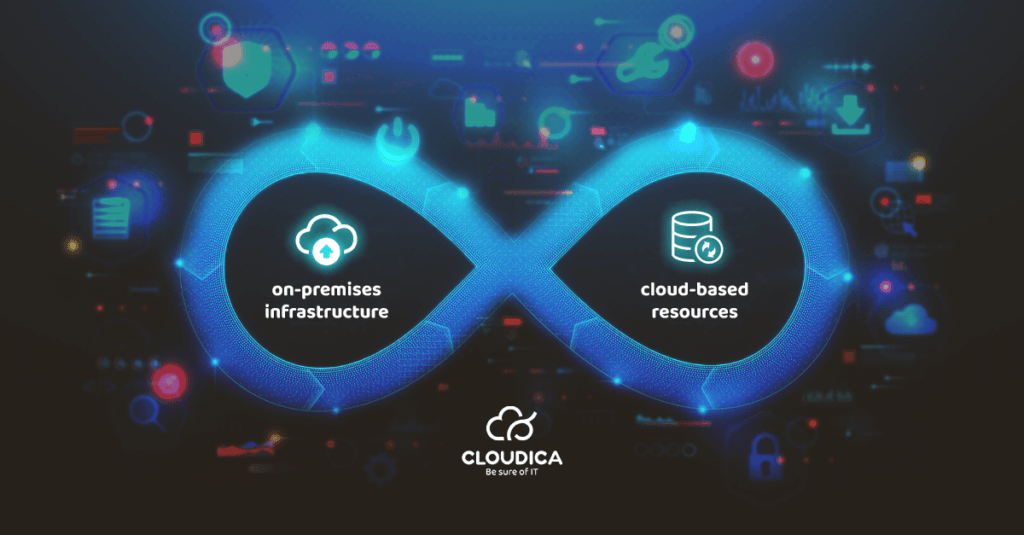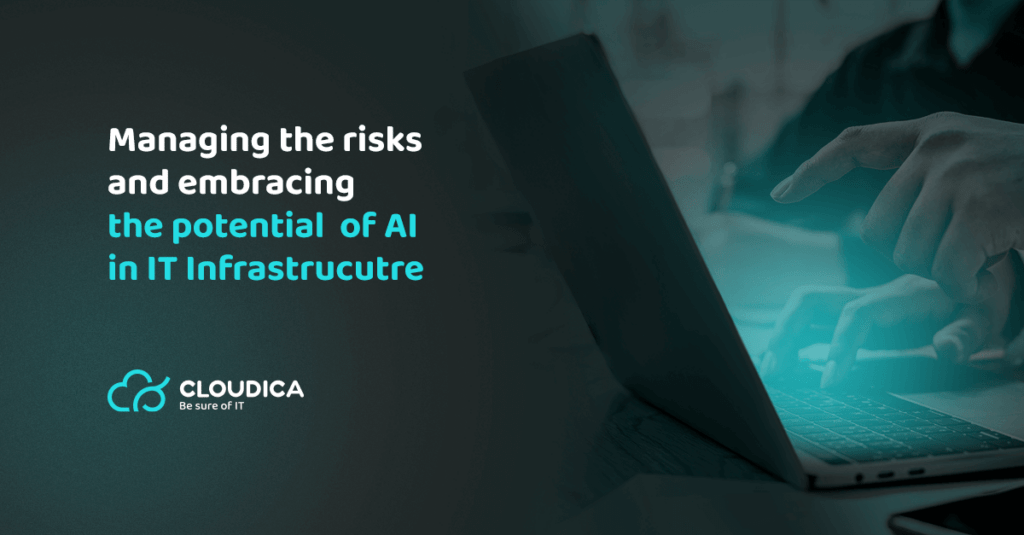As the CEO of Cloudica, a company focused on cloud technologies, I am excited to explore how artificial intelligence (AI) can revolutionize IT infrastructure and security. AI has the potential to transform the way we manage IT operations, improve efficiency, optimize performance, and enhance security measures. However, significant risk factors must also be considered. In this article, I will delve into the ways in which AI can be used to improve IT infrastructure and security.
AI and ON-PREMISEs Infrastructure
On-premises infrastructure refers to the physical hardware and software located on-site at a company’s premises. I see several areas where AI can improve on-premises infrastructure management. One that comes to mind is predicting hardware failures and automating routine maintenance tasks, ultimately reducing downtime and improving productivity.
AI could predict hardware failures by analyzing data from various sources, such as sensors, log files, and system performance data. By analyzing this data, AI algorithms can identify patterns and anomalies that may indicate impending hardware failures. For example, an AI algorithm may analyze the temperature and vibration data from a server’s sensors to identify patterns that indicate that a particular component, such as a hard drive or power supply, is likely to fail. The AI may also analyze log files and system performance data to identify patterns that indicate degraded performance or other issues that could lead to hardware failures.
Once the AI has identified potential hardware failures, it can alert IT teams or system administrators so that they can take proactive measures to prevent downtime and reduce the risk of hardware failures. This can include scheduling maintenance activities, replacing hardware components before they fail, and optimizing resource allocation. It is important to note that such capabilities can also be used for other machinery like production lines.
AI has the capability to automate routine maintenance tasks by analyzing data from different sources and using machine learning algorithms to detect patterns and anomalies. This allows AI to recognize tasks that can be automated, such as security patching, software updates, and backup and recovery operations. For example, AI algorithms can analyze system performance data to detect patterns indicating that a software application or operating system requires updates or patches. This allows the AI to automatically schedule and deploy the necessary updates, decreasing the workload on IT teams and reducing the likelihood of errors.
Additionally, AI can analyze backup and recovery data to identify patterns indicating that specific data or applications need more frequent backups or recovery operations. The AI can then schedule and execute these tasks automatically, ensuring that the data is appropriately protected and minimizing the risk of data loss or downtime.
By automating routine maintenance tasks, organizations can streamline IT infrastructure management, reduce the workload on IT teams, and increase the efficiency and effectiveness of maintenance operations. This enables organizations to concentrate on strategic tasks, such as innovation and delivering superior outcomes to their customers and stakeholders.
AI and Hybrid Infrastructure

Next, let’s talk about hybrid infrastructure. Hybrid infrastructure combines on-premises infrastructure with cloud-based resources, creating a more flexible and scalable IT environment. However, managing hybrid infrastructure can be complex, requiring careful workload placement across public and private clouds.
I bet, that AI can help manage this complexity by optimizing workload placement and ensuring that resources are used efficiently.
AI can do this by analyzing usage patterns, resource requirements, and cost considerations to determine the best environment for each workload. This can include on-premises infrastructure, public or private clouds, or a hybrid combination of both.
For example, an AI algorithm can analyze the performance and resource usage of workloads running on-premises and in the cloud, to determine the best placement for each workload. By considering factors such as cost, performance, and security, the AI can identify the optimal placement for each workload, maximizing resource utilization and reducing costs.
Additionally, AI can use machine learning algorithms to predict future demand and workload patterns, enabling IT teams to adjust workload placement accordingly. This can include scaling workloads up or down or moving workloads to different environments based on predicted demand.
By optimizing workload placement in hybrid infrastructure, AI can improve performance, reduce latency, and lower costs, ultimately delivering better outcomes for the organization. This also enables IT teams to focus on more strategic tasks, such as innovation and delivering superior value to customers and stakeholders.
AI and Cloud Security
We know that security is a top concern for many organizations. With more and more data being stored in the cloud, protecting against data breaches and managing access controls is more important than ever. AI can help address these challenges by using machine learning to detect anomalies in user behavior and identify potential security threats.
For example, AI can analyze user activity data, such as login times, access requests, and resource usage, to build a model of normal user behavior. The AI can then compare user behavior to this model, and alert security teams when behavior deviates significantly from the norm. This can include identifying login attempts from unusual locations or at unusual times, or access requests for resources that the user does not typically use.
Additionally, AI can use machine learning algorithms to detect anomalous behavior at the system level, such as unusual traffic patterns or network activity that may indicate a potential security threat. By detecting these anomalies early, security teams can respond quickly to mitigate the threat and prevent data breaches or other security incidents.
By using AI to detect anomalies in user behavior and identify potential security threats, organizations can improve their security posture and reduce the risk of data breaches or other security incidents. This enables organizations to focus on their core business objectives, confident in the knowledge that their systems and data are secure.
AI and Cloud Infrastructure Management
Cloud infrastructure management can be complex and time-consuming, but AI can help automate many tasks, such as resource allocation and scaling. Additionally, AI can optimize cost management by identifying cost-saving opportunities and predicting usage patterns. For example, a retail company might use AI to predict demand for certain products and adjust their cloud resources, accordingly, reducing costs and improving customer satisfaction.
The other possibility is to use multi cloud approach and optimize workload dynamically through different cloud providers. Rationale can be costs, but also performance or specific features of services in the specific cloud.
How AI can Improve IT Infrastructure Management

There are various ways in which AI can be used to improve the performance, efficiency, and security of IT infrastructure. There are five key areas where AI can make a significant impact, including predictive maintenance, automated resource allocation, workload optimization, security threat detection, and cost optimization. By leveraging AI, IT teams can proactively identify and address potential issues, optimize resource usage, improve workload placement, enhance security, and reduce unnecessary spendings.
- Predictive Maintenance
AI can help predict when hardware failures or maintenance issues are likely to occur in IT infrastructure, such as servers and storage devices. This enables IT teams to take proactive measures to prevent downtime and reduce the risk of hardware failures.
- Automated Resource Allocation
AI can automate the allocation of computing resources across an IT infrastructure, such as cloud resources or server clusters. This helps optimize the use of resources and ensures that computing power is available where it’s needed most.
- Workload Optimization
AI can analyze workload patterns and usage data to optimize workload placement across different IT infrastructure environments. This ensures that workloads are running on the most appropriate infrastructure, whether on-premises, cloud-based or hybrid environments.
- Security Threat Detection
AI can detect and respond to security threats, such as malware, unauthorized access, and other malicious activity. This helps reduce the risk of data breaches and improves overall security posture.
- Cost Optimization
AI can optimize IT infrastructure costs by analyzing usage patterns, identifying cost-saving opportunities, and predicting future demand. This enables IT teams to optimize resource allocation and reduce unnecessary spending on computing resources.Top of Form
Potential Risks of Using AI in IT Infrastructure Management
While AI has the potential to transform IT infrastructure management, there are also risks associated with its use. Here are some potential risks with AI in the context of IT infrastructure:
- Bias and Inaccuracy
AI algorithms are only as good as the data they’re trained on. If the data is biased or inaccurate, the AI may produce biased or inaccurate results. This can lead to poor decision-making and potentially negative impacts on IT infrastructure.
- Security Risks
AI may introduce new security risks, such as vulnerabilities in the algorithms themselves or the use of data sources that are not properly secured. Additionally, AI may be vulnerable to adversarial attacks, where malicious actors attempt to manipulate the AI algorithms.
- Complexity
The use of AI may add complexity to IT infrastructure management, requiring specialized skills and expertise. This can make it more difficult to manage IT infrastructure and may increase the risk of errors or oversights.
- Cost
The implementation of AI may require significant investments in hardware, software, and personnel. This can be a significant cost for organizations and may require careful cost-benefit analysis to ensure that the benefits of AI outweigh the costs.
- Ethical and Legal Concerns
The use of AI may raise ethical and legal concerns, such as privacy violations, data misuse, or unintended consequences. Organizations must carefully consider these concerns and ensure that their use of AI is ethical and legal.
Managing the Risks and Embracing the Potential of AI in IT Infrastructure

Overall, the risks associated with AI in the context of IT infrastructure must be carefully considered and managed. Organizations should ensure that they have the necessary expertise, resources, and safeguards in place to manage these risks effectively. By doing so, they can leverage the power of AI to optimize their IT infrastructure and deliver better outcomes for their organizations.
In conclusion, AI has the potential to revolutionize the way we manage our IT operations, from on-premises infrastructure to cloud security. By leveraging the power of AI, companies can improve efficiency, optimize performance, and enhance security measures. As we move forward, it’s important to consider how AI can improve our own IT operations and continue to innovate in this exciting space.




